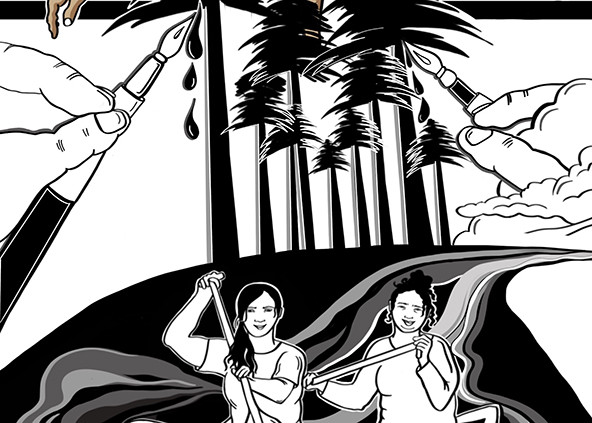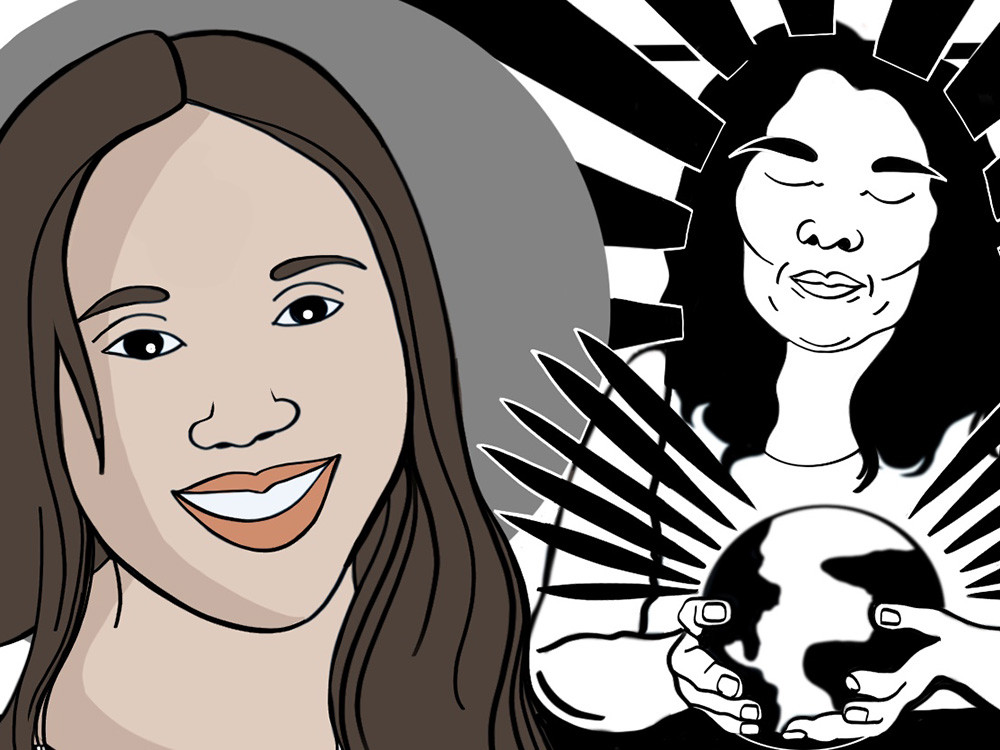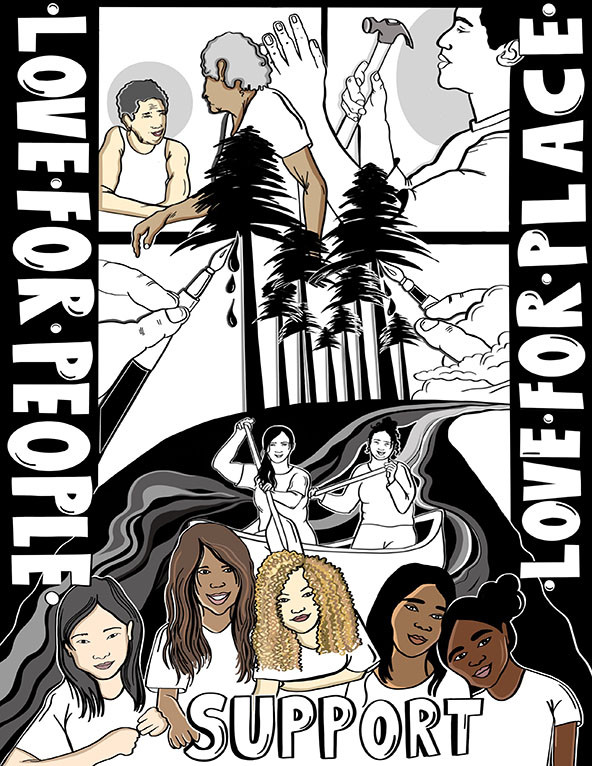 (Illustration by Taslim van Hattum)
(Illustration by Taslim van Hattum)
Del Norte County encompasses a section of coastline in the far northwest corner of California that is the ancestral home of the Yurok and Tolowa people. Though ecologically and culturally rich, the county ranks in the bottom eighth in California for per-capita income. For millennia, oceans, rivers, and forests provided an abundance of food and other resources for the residents of this area, until the late 1800s, when white settlers arrived and began to extract gold and timber. As happened across California the Indigenous people survived some of the worst genocidal campaigns and land seizures in United States history. Colonization set the stage for the development of a community fractured along racial and economic lines, centered on resource extraction with boom-and-bust economic cycles that have reverberated to the present day. Multiple generations of residents in Del Norte County have now suffered from widespread childhood obesity, low educational achievement, high teen drinking rates, poor health outcomes, and other social problems linked to high rates of trauma, unemployment, and poverty.
Many of the Indigenous families intact with language and culture today are here in large part to the strength and resilience of grandmothers and great-grandmothers, who endured forcible removal to boarding schools, stripping them of language and access to lifeways. These are the women that came back and built many of the foundational and educational programs still standing today, such as United Indian Health Services, North Coast Indian Development Corporation, and the Native Cultures Fund.

For this reason, The California Endowment (TCE) chose Del Norte and the Yurok and Tolowa Dee-ni’ Tribal lands as one of 14 communities included in Building Healthy Communities (BHC), a 10-year-long initiative aiming to improve health outcomes among the most vulnerable and marginalized communities in the state. A regional backbone organization—Wild Rivers Community Foundation, an affiliate of Humboldt Area Foundation—was tapped to manage the initiative in partnership with community leaders and TCE program officers and staff.
It was in this context that the authors began working together: Michelle as initiative director of the BHC Collaborative in Del Norte County and Tribal Lands and Geneva as TCE’s program officer. Our relationships to the place were different: Geneva is a Yurok Tribal member, with deep family, spiritual, and cultural ties to the Klamath River and its watershed, while Michelle grew up on the coasts of southern Oregon and Southern California, with an ancestry made up of Dutch immigrants, Chicanos, and Lakota people. But for both of us, this place, where the redwoods meet the sea was home, the community where we were each raising a daughter (both with the nickname Ani). Statistically, our girls were more likely to drop out of high school or become teen parents than they would be to graduate high school prepared for university. But along with our shared fears, we had shared hope and bold dreams that we could make our community a better place for families at all income levels.
Both of us had had direct experience of how philanthropy could make a big difference in people’s lives, and both are living examples of how investing in building the capacity of rural and Tribal people pays off. Geneva benefited from the Ford Foundation’s strategy to invest in developing future policy makers of color: With Ford Foundation support, she became the first in her extended family to earn an advanced degree, and then the W.K. Kellogg Foundation’s investments in Americans for Indian Opportunity program provided her with deep healing, leadership development, and connection to a global network of Indigenous leaders. Michelle benefited from the Ford Family Foundation’s Institute for Leadership Program, which brought cohorts of rural community leaders together to work on a collaborative project and provided numerous advanced facilitation and grant writing courses, allowing Michelle to receive high-quality training in community power building skills in her home community.
The Challenge of Change in a Rural Community
When Building Healthy Communities launched in 2009, we knew it would be a challenge to improve the social determinants of health. The factors leading to poor outcomes—few employment or education opportunities, substandard housing, segregated neighborhoods, and more—were baked into the community’s social structure. Efforts to make change could be seen by many as threatening. Burning bridges in a small tight-knit community comes at great personal cost.
However, a rural community’s small size can give community organizers unique opportunities. When there aren’t many significant funding streams or interventions being made, it’s easier to see if what you are doing is making an impact. The close interconnections among people can also work to your advantage: Word-of-mouth mobilization and promotion can be very effective because messages travel quickly. There is a level of access that you just can’t get in a city. When the local judge is also your kid’s soccer coach and sits on your board, you are not distant from the local centers of power.
We began with a year of community engagement, with the goal of building a shared vision of change. Community leaders identified the issues the community thought most important. At the time, there were few nonprofit organizations, and none with the core mission of doing intersectional, values-based community organizing and leadership development. To fill this gap, the community foundation incubated a grassroots community organizing effort, which eventually became a nonprofit organization called True North Organizing Network. It was the best approach we knew at the time for transforming systems and policies to improve health equity.
Five years in, the energy of community engagement and the momentum of a few early wins had dwindled. Feeling enormous responsibility toward their individual clients and constituents, grant-funded staff members shifted their work focus from systems change to program delivery. The community organizing group had grown up into a functioning organization but had shifted its attention and alignment to state and national campaigns and couldn’t devote time to the local power analysis we felt was necessary. Groups of good-hearted community leaders still gathered regularly, but they met mostly to share information rather than to analyze data or make plans for action. Young people, parents, and community leaders could all name tensions getting in the way of positive change: We couldn’t decide whether to prioritize capacity building or the changing of specific outcomes; whether to go fast or to go slow; or whether change should be driven by policymakers or by the people. We weren’t in a crisis situation, but it felt like the work was about carrying out the initiative rather than pushing for the systemic changes we knew were needed. Once the 10-year funding ended, we wondered, would the work end, too? We weren’t quite sure what to do. And, in the background, our daughters were growing up in a community where little was changing.
We called a pit stop and gathered the people most deeply invested. We were hearing that BHC grantees all over the state were pushing for greater control over use of grant funds and a shift toward the building of “people power.” This helped us distinguish between what we had been doing right and what was getting in the way. We told our gathered partners that we wanted to move the focus away from grant deliverables and the status of programs to the well-being of the people of our community. We asked people to imagine an ideal experience for families and kids growing up in the community, to compare that with the experience people have today, and to envision closing the gap between the two. Our goal was not just to define needs and goals but to open the door toward community members feeling empowered to make the needed changes.
Building People Power
This reorientation transformed how we thought about the initiative. We were now doing community power building with an explicit human-centered design approach. We committed to the shared vision of guaranteeing “that growing up in Del Norte and Tribal Lands fosters lifelong health and success for all.” We focused on growing leaders with the capacity to reimagine and redesign the places that influence our children, our neighborhoods, and schools. We built a hub to bring together diverse groups of residents, youth, community partners, government agencies, and nonprofits to solve complex systemic problems and work toward health equity. With community power building as our touchstone, we embarked on a mission that we knew would outlive our BHC funding.
 (Illustration by Taslim van Hattum)
(Illustration by Taslim van Hattum)
Wild Rivers Community Foundation became a true hub of capacity building and strategic alignment, providing technical assistance for a multitude of community-driven initiatives. With the coaching and facilitation support of the consultancy ThinkPlace, we designed a capacity building and leadership development program that brought together young people, parents, nonprofit leaders, and Tribal government staff members; together, we practiced how to transform systems to achieve racial and health equity. Over the years that followed, we saw improved indicators in early childhood education, college and career readiness, local healthy food access, youth leadership and entrepreneurship, and overall community health ranking. As we write this, we see strong evidence that these positive trends continue.
Looking back over our experience with BHC, we can see several factors leading to successful outcomes. Of primary importance was the collaborative relationship Wild Rivers Community Foundation formed with The California Endowment. TCE accepted the broadest definitions of accountability, and together we worked towards achieving our goals for the community, knowing we could not let the formal demands of the initiative get in the way.
Three other factors stand out as critical:
Funding infrastructure development and capacity building. Infrastructure, expertise, and knowledge are necessary for growing community power. To compensate for their under-development in rural and tribal communities, it’s necessary to make long-term commitments to funding backbone functions, community capacity building in systems and power analysis, transformational relationship development, and leadership and governance capacity. Successful development of this infrastructure is key to ensuring that your impact will outlast the funding.
Avoiding a one-size-fits-all approach. Every community is unique. And within a community, the unique histories and circumstances of different populations—Indigenous people in particular—matter a great deal. You cannot assume that available data tell you what people need. All of this makes listening very important. For example, The California Endowment in 2010 did not anticipate that residents of the Yurok reservation would want prescribed forest fires to be the first action taken on their journey to Build a Healthy Community, and yet, a 10-year commitment and real listening, allowed for truly transformative community-driven solutions to emerge as sustainable, long-term solutions.
Recognizing that foundation staff can play powerful roles. Foundation staff can mitigate some of the disadvantages of geographic isolation and distance from the centers of policy making. They have a unique field-level view and relationships with other funders and policy makers. They can use their links to the power ecosystem to connect, convene, and inform.
A Future for Our Daughters
We measure our success from the perspective of our children. Thanks in large part to The California Endowment’s decision to invest in our community more than 13 years ago, the odds are shifting in our daughters’ favor. Both Anis have been fortunate to have access to high-quality early childhood education, including a preschool that emphasizes hands-on learning. They have witnessed young people taking action, registering over 950 individuals to vote and organizing town halls with county supervisor candidates. They have seen registered nurses graduate from our local Del Norte Community College and bravely serve on the front line during the challenging times of the pandemic. They have observed youth start their own consulting businesses and nonprofit organizations. And they have been inspired by young women from our community speaking at global platforms like the United Nations climate summit.
Our daughters know that they have a place in this community if they choose to stay or return to after having adventures and experiences elsewhere. That’s because we have built a coalition of youth and adults who know how to collaborate, their commitment fueled by empathy, understanding, and connection. Under the mantra of “we all belong,” our community can now envision a thriving society for all. Thirteen years ago, we could not say that.
Perhaps the most important legacy of Building Healthy Communities is that our community now has the capacity to bring to fruition our vision of a thriving society for all. We understand that optimal health and well-being for all requires a long-term, multi-generational effort to dismantle the structures that maintain inequality and to heal the harms of settler colonialism.
Recent triumphs, such as the Yurok Tribe securing a five-year, $30 million Promise Neighborhoods grant, demonstrate our community’s ability to collaborate effectively. This grant will further advance the life outcomes of people in our community and may mark the beginning of a new chapter in our work. Our values and mindsets have evolved since we began our collaboration with The California Endowment, and the hopes and dreams we have co-designed with our community partners are interwoven throughout. They serve as the binding that supports the many chapters yet to be written in our collective book.
Building Healthy Communities—Del Norte and the Yurok and Tolowa Dee-ni’ Tribal lands case studies, research, and policy briefs are archived here (California Center for Rural Policy at Cal Poly Humboldt).
Support SSIR’s coverage of cross-sector solutions to global challenges.
Help us further the reach of innovative ideas. Donate today.
Read more stories by Michelle Carrillo & Geneva Wiki.

